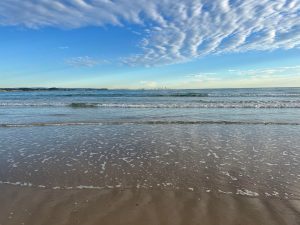29th NSW Coastal Conference
At last the NSW coastal family has managed to come together in person. Hopefully the days of hybrid and online conferences are over. Old and new faces gathered close to the shore at Mantra on Salt, Kingscliff in far northern NSW. Our hosts were Byron and Tweed Shire Councils. With an attendance of just over 270 this meeting reopened the opportunity that we in NSW benefit from our annual exchange of ideas, information, and reflections. The combined shires offered delegates an opportunity both privately and through field trips to visit the great sweep of beaches from Cape Byron to the Queensland border and productive estuaries such as the Tweed. The welcome to country by local indigenous representatives and speeches from respective shire mayors beautifully captured the spirit of the location for this year’s conference. It was reassuring to delegates to see the Minister for Local Government, Wendy Tuckerman MP, come to open the conference and stay for the full first session. And the final keynote address by a school student, Sabyah White, titled “Biophilia”, gave us great hope that a future generation exists who will strive to protect our wonderful natural environments.
The past few years of fires, Covid and floods have not deterred our collective passion for addressing coastal issues. It was in this context that our theme this year was “living with uncertainty”. We followed the usual structure of keynote addresses, break out special sessions, exhibitors and social gatherings including a dinner. I again had the privilege of presenting awards at the dinner. It is always an honour to be involved in some way at NSW Conferences and that also includes presenting the poster award and giving the conference wrap up. We are indebted to East Coast Conferences for their efficient management of the conference and to the local organising committee, especially Chloe Dossett from Byron and Jane Lofthouse of Tweed Shire Council, and our various sponsors.
We all have our various take aways from these conferences. Mine ranged from presentations that were technical, such as application of new tools for monitoring shoreline and river/lake entrance change, to more broader issues associated with impacts of climate change and the roll out of the NSW Coastal Management Framework. Specifically I was struck with discussion around a keynote on coastal risk impact on the Australian property market. This presentation sparked reaction from many participants in its very narrow definition of risk, how a certain method was applied, and what results were to be made available to the finance sector. This commercialisation of risk advice without embracing knowledge from sources compiled at state and local levels could place unnecessary burdens on property owners. In contrast, several papers, that embraced the emerging opportunities of what Will Glamore termed “environmental-economic pathways”, demonstrated how carbon storage and legal covenants in coastal wetlands are a way forward, in particular in areas affected by rising sea levels. This gives land holders assessment tools to apply blue carbon market opportunities in coastal estuaries in NSW and elsewhere in Australia.
Coastal erosion is always a hot topic in NSW. Delegates had the chance to visit locations such as Kingsland where Tweed Council benefited from a federal grant to protect its foreshore and create a very attractive public space. Nearer the border the by-passing of sand into Queensland over the past 20 or so years gives coastal scientists the opportunity to analyse sediment transport processes and local beach impacts. Further south at Byron Bay issues of shoreline recession remain very much alive and of continuing concern for the local council, landholders, and community. Uncertainty around who owns the beach is very much an unresolved issue and discussion around this topic will remain controversial unless more definite steps are taken to clarify “who owns the beach” and the importance of protecting the public interest.
Estuary management formed the subject of many papers. Of concern was the difficulty some councils face in coordination of government agency actions in the development of Coastal Management Programs (CMPs). According to many councils such problems are compounded by the extent to which their CMPs can include actions in areas that lie outside the mapped statutory “Coastal Zone”. Such actions are deemed necessary to ensure waterway health. Also of interest was a need to find ways to better manage ICOLLs. NSW is endowed with many such coastal lakes. Some councils are under pressure to artificially open entrances to prevent flooding of properties and improve recreational use. A workshop on ICOLLs was held prior to the conference and attracted considerable interest. Improved tools for monitoring entrance condition and water quality were outlined at the conference. There was call for such new information to be made more accessible.
It was my pleasure to announce at the closing session the venue for the next conference. But this will be one with a difference! Newcastle City Council has kindly agreed to host the 30th NSW Conference BUT it will also be the next National Coast to Coast Conference. The Australian Coastal Society will serve as co-host and work closely with Newcastle Council in organising this event in November 2023. A meeting in July will set in train details on dates and other arrangements. I sincerely hope to engage the new Australian Government in activities at this conference. Newcastle region offers scope for participants from all over Australia to join with the NSW coastal family and learn of the many management activities underway by this and adjoining councils (Lake Macquarie and Port Stephens). We plan to offer an exciting program that will enable all who attend to better address the challenges we all face.
Bruce Thom
Words by Prof Bruce Thom. Please respect the author’s thoughts and reference appropriately: (c) ACS, 2022. For correspondence about this blog post please email austcoastsoc@gmail.com
#216



 Lament for Estuaries?
Lament for Estuaries?